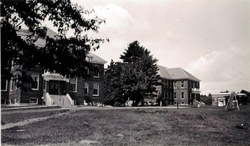Laconia State School
| Laconia State School | |
|---|---|
 | |
| Established | 1901 |
| Construction Began | 1903 |
| Opened | 1903 |
| Closed | 1991 |
| Current Status | Closed |
| Building Style | Cottage Plan |
| Location | Laconia, NH |
| Alternate Names |
|
Contents
History
The New Hampshire School for the Feeble-minded opened in 1903 with 82 residents in three buildings. The site was built on 250 acres of land overlooking Lake Winnisquam and Lake Opechee. It housed people between the ages three and 21, but in 1905 it allowed women over 21. The school added a hospital, a farm, a dining hall, and a woman's dormitory by 1910. In 1916 overcrowding set in with 300 residents. The school's name changed in 1924 to the Laconia State School.
During the Great Depression, many families had fewer resources, so they sent their children to the school, where they would at least be fed. Every time the school faced problems, the Legislature refused to increase its budget. Requests for funds for repairs and expansion fell on deaf ears. In 1942, the school had 600 residents, who were served by staff working 51 hours a week, leaving one staff member to care for 30 to 35 residents. Time was increased for education and training, more steps towards individual privacy was made, a geriatrics unit was added, and there were introductions to co-educational activities. In 1953, parents, with help from Hungerford, formed the New Hampshire Council for Retarded Children. However, after being viewed with hostility, in 1960, Hungerford was forced to resign.
The population continued to increase, with 1,000 residents, and a wait list of 400 in 1974. There was never enough staff to care for the residents. Parents decided to file a suit towards the state for failing at its own law, which stated "the Division of Mental Health to establish, maintain, implement, and coordinate a comprehensive serviceable delivery system for developmentally disabled persons". The reduction of 230 residents was ordered by the Garrity vs. Gallen ruling, but instead it was decided to slowly reduce the numbers until there were no residents left.
In 1991, the facility that was once Laconia State School became Lakes Region Facility, a state prison. But the plans to make the old school into a prison was challenged, as locals didn't want a prison in their town. In 1997, LRF became a permanent facility. The 300 cap was increased to 500 with the capability of expanding to 600 beds in the future. The buildings, many of them built in the 19th century, had been vacant and in disrepair. An inmate labor force was responsible for nearly all of the major renovations. Consequently upon completion, both male and female inmates would be housed at LRF to participate exclusively in substance abuse, educational, self-improvement and other programs.[1]
The prison closed in 2009. In 2019, NBBJ, a Boston consulting firm, presented a master plan for mixed use development of the property. The plan called for 345 housing units, including single-family, starter homes, townhouses and apartments. It also included recreational facilities, a boutique hotel and 32,500 square feet of retail, restaurant and office space. Since 2010, the state has spent more than $300,000 a year securing and maintaining the vacant property, an appropriation that is set to decrease to $232,000 in fiscal years 2022 and 2023.
Images
Cemetery
Over the years some residents were buried in unmarked graves at random locations near the school before this cemetery was opened in 1941. As before, the burials were unmarked graves until the parents organized and asked that all the unmarked graves be identified. In 1976, marked gravestones, purchased by the parents, were laid over each of the graves.
Video
The following is a documentary on both Laconia State School and also the people who had been sent there. This film was directed, produced, edited, and uploaded to YouTube by 1L Media.
References
- ↑ From the New Hampshire Department of corrections web site
